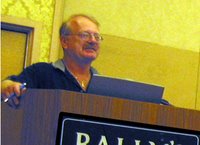 Dan Voss is a technical communicator with 28 years of experience in the aerospace industry. An STC Fellow and active member of the AccessAbility SIG and STC Orlando, Dan understands the challenges and opportunities facing today’s technical communication professionals. In his presentation at this year’s conference, he argued that technical communicators are uniquely positioned to interact with and moderate among teams in marketing, advertising and PR.
Dan Voss is a technical communicator with 28 years of experience in the aerospace industry. An STC Fellow and active member of the AccessAbility SIG and STC Orlando, Dan understands the challenges and opportunities facing today’s technical communication professionals. In his presentation at this year’s conference, he argued that technical communicators are uniquely positioned to interact with and moderate among teams in marketing, advertising and PR.Welcome to the Blog at STC Chicago, Dan! Thank you for sharing your views about integrated strategic communication with us.
Q: Why should technical communicators care about the synergy between technical communication and marketing?
A: For several reasons. First, the synergy between technical communication and marketing communication can add substantial business value to information products—helping your company or clients win new business and defend the business they have. Second, technical marketing communication offers excellent career opportunities for technical communicators because it requires a unique combination of technical understanding and core communication skills that we possess. Third, if you are in “corporate America,” internal business alliances are an important part of both organizational and individual success. In the aerospace industry, for example, technical marketing communication requires a close alliance among technical communicators, business development, engineering, and program management—pairing us with three of the most powerful disciplines. That, in turn, increases our influence and our respect within the company—both as an organization and as individual professionals. Fourth, technical marketing communication is exciting. It’s varied, it’s high-energy, and it’s fun.
Q: You’ve worked extensively with remote teams to incorporate video and other multimedia into your proposals. Are you convinced that new media tools enhance the technical communicator’s ability to engage and persuade an audience?
A: Absolutely, especially when that audience consists of high-level decision-makers who are less technical (e.g., Congressional staffers, top military officers, corporate executives). Video and multimedia are somewhat less important when you’re dealing with a detail-oriented highly technical audience, but they can have a role in informing and clarifying as well as in persuading, so I believe they are also effective across a heterogeneous audience. As an example, in the technical volume of the proposal I described in the conference session, we included more than 40 imbedded video clips showing tests of missile subsystems. The primary readership of that volume was a highly technical audience, yet the video was still able to accentuate our theme of high product maturity and low development risk. For top-level audiences, we also provided an executive summary video, in addition to the hard-copy exec sum that was called for in the RFP. And multimedia was a critical element in the marketing/media campaign that followed submission of the proposal, because here again, the target audience was non-technical.
Q: Do you find today’s technical communication professionals ready and willing to integrate video and other multimedia into complex documentation projects?
A: It’s hard for me to comment meaningfully on that, because I have been with one company for the past 28 years, and it happens to be a company (and a communications department) where the value of integrated communication across a full suite of media has been demonstrated and the process is integral to our new business pursuits. I can only offer a speculative answer to this question based on my observations when I have made presentations on integrated communication for STC, both at the chapter level and the international level, as well as an analysis of the feedback that comes with the conference evaluation forms. To generalize, I think audience members who are documentation specialists are definitely interested in—in some cases, even intrigued with—the possibility of integrating video and multimedia into their projects, but some audience members found the “full-court press” we put on in the media/marcom campaign, while interesting, to be far afield from their day-to-day job responsibilities in documentation.
Q: Is it fair to say that, in order to create successful technical proposals, technical communication professionals need to be well-versed in new media strategies?
A: Not so much on the proposals themselves, but definitely the media/marketing campaigns that often accompany and/or follow proposal submission, in an effort to influence the source selection process. Note that my experience is entirely within aerospace, so I cannot speak knowledgeably concerning the degree to which the integrated communication concept (proposal plus media/marcom activity) applies there, but I would imagine that a broader skill set would make enable technical communication professionals to provide increased business value in that environment as well.
Thanks again, Dan, for taking time to talk with us about integrated communication and the technical communication profession.

No comments:
Post a Comment